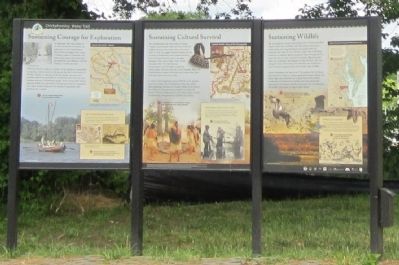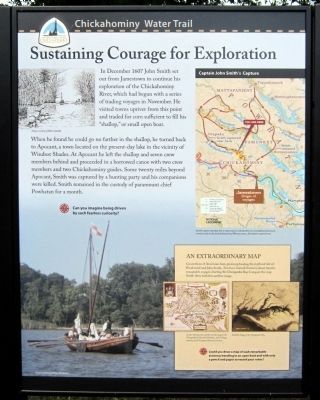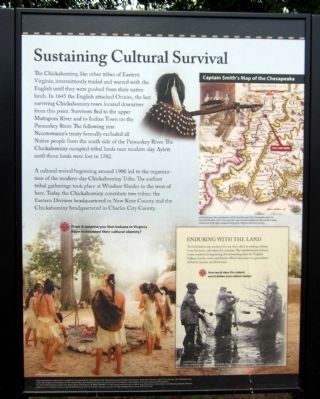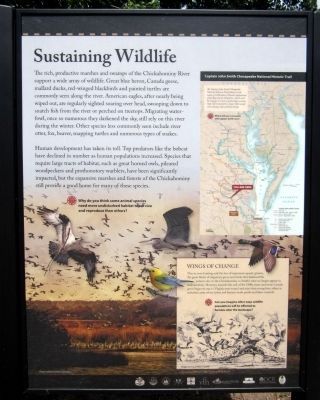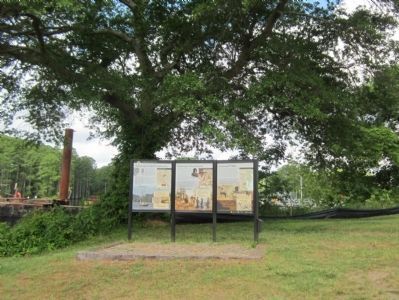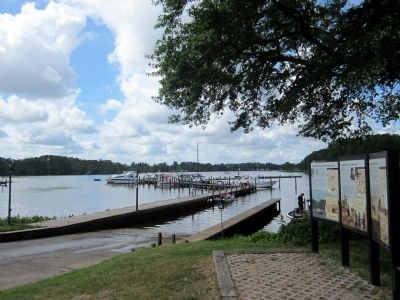Near Walker in New Kent County, Virginia — The American South (Mid-Atlantic)
Chickahominy Water Trail
(left panel)
Sustaining Courage for Exploration
In December 1607 John Smith set out from Jamestown to continue his exploration of the Chickahominy River, which had begun with a series of trading voyages in November. He visited towns upriver from this point and traded for corn sufficient to fill his “shallop,” or small open boat.
When he found he could go no farther in the shallop, he turned back to Apocant, a town located on the present—day lake in the vicinity of Windsor Shades. At Apocant he left the shallop and seven crew members and proceeded in a borrowed canoe with two crew members and two Chickahominy guides. Some twenty miles beyond Apocant, Smith was captured by a hunting party and his companions were killed. Smith remained in the custody of paramount chief Powhatan for a month.
Can you imagine being driven by such fearless curiosity?
(sidebar)
An Extraordinary Map
Generations of Americans have grown up hearing the mythical tale of Pocahontas and John Smith. Few have learned, however, about Smith’s remarkable voyages charting the Chesapeake Bay. Compare the map Smith drew with this satellite image.
Could you draw a map of such remarkable accuracy traveling in an open boat and with only a pencil and paper to record your notes?
(captions)
(top right) Captain John Smith's Capture Smith's captors marched him to many native communities in a roundabout journey of several weeks to the final destination of Werowocomoco, Powhatan;s capital town.
(sidebar left) A color reproduction of John Smith's map of the Chesapeake by Hendrik Hondius, 1630. Image courtesy of the Virginia Historical Society.
(sidebar right) Satellite image of Chesapeake Bay.
(center panel)
Sustaining Cultural Survival
The Chickahominy, like other tribes of Eastern Virginia, intermittently traded and warred with the English until they were pushed from their native lands. In 1645 the English attacked Orinies, the last surviving Chickahominy town located downriver from this point. Survivors fled to the upper Mattaponi River and to Indian Town on the Pamunkey River. The following year Necotowance’s treaty formally excluded all Native people from the south side of the Pamunkey River. The Chickahominy occupied tribal lands near modern-day Aylett until those lands were lost in 1702.
A cultural revival beginning around 1900 led to the organization of the modern—day Chickahominy Tribe. The earliest tribal gatherings took place at Windsor Shades to the west of here. Today the Chickahominy constitute two tribes: the Eastern Division headquartered in New Kent County and the Chickahominy headquartered in Charles City County.
Does it surprise you that Indians in Virginia have maintained their cultural identity?
(sidebar)
Enduring With the Land
The Chickahominy continued to use their skills in making a living from the lands and waters for centuries. The establishment of Jamestown marked the beginning of a devastating time for Virginia Indians, but the rivers and forests offered sustenance to generations of Native hunters and fishermen.
How much does the natural world define your culture today?
(captions)
(top right) Captain John Smith's Map of the Chesapeake A detail from a color reproduction of John Smith's map of the Chesapeake region by Hendrik Hondius, 1630. Note that this map is oriented differently than modern maps, with north to the right. Image courtesy of the Virginia Historical Society.
(sidebar) Chickahominy Indians fishing, 1918. Image courtesy of the National Museum of the American Indian, Smithsonian Institution.
These interpretive signs were created by the James River Association with the assistance of Charles City County, New Kent County, James City County, the Chickahominy Tribe, the Virginia Foundation for the Humanities, the Virginia Council on Indians, and the Virginia Department of Conservation and Recreation.
(right panel)
Sustaining Wildlife
The rich, productive marshes and swamps of the Chickahominy River support a wide array of wildlife. Great blue heron, Canada geese, mallard ducks, red-winged blackbirds and painted turtles are commonly seen along the river. American eagles, after nearly being wiped out, are regularly sighted soaring over head, swooping down to snatch fish from the river or perched on treetops. Migrating waterfowl, once so numerous they darkened the sky, still rely on this river during the winter. Other species less commonly seen include river otter, fox, beaver, snapping turtles and numerous types of snakes.
Human development has taken its toll. Top predators like the bobcat have declined in number as human populations increased. Species that require large tracts of habitat, such as great horned owls, pileated woodpeckers and prothonotory warblers, have been significantly impacted, but the expansive marshes and forests of the Chickahominy still provide a good home for many of these species.
Why do you think some animal species need more undisturbed habitat to survive and reproduce than others?
(sidebar)
Wings of Change
Due to over-hunting and the loss of important aquatic grasses, the great flocks of migratory geese and ducks that darkened the autumn sky on the Chickahominy in Smith's time no longer appear in such numbers. However, towards the and of the 1900s, more and more Canada geese begun to stay in Virginia year-round and raise their young here, often in suburban areas where lawns and human-made ponds and lakes coincide.
Can you imagine other ways wildlife populations will be affected as humans alter the landscape?
(captions)
(top right) Captain John Smith Chesapeake National Historic trail The Captain John Smith Chesapeake National Historic Trail follows in the wake of 3,000 miles of Smith’s exploration of the Bay and its tributaries. Smith used his voyages to create a surprisingly accurate map and to document a region that would soon undergo unprecedented change. Where will you cross paths with Captain Smith next?
Erected by James River Association.
Topics and series. This historical marker is listed in these topic lists: Colonial Era • Environment • Exploration • Native Americans • Settlements & Settlers. In addition, it is included in the Captain John Smith Chesapeake National Historic Trail series list. A significant historical month for this entry is December 1607.
Location. 37° 24.415′ N, 76° 56.203′ W. Marker is near Walker, Virginia, in New Kent County. Marker is on Outpost Road, 0.6 miles south of Rockahock Road, on the right when traveling south. Located near the boat launch at Rockahock Campground. Touch for map. Marker is at or near this postal address: 1428 Outpost Road, Lanexa VA 23089, United States of America. Touch for directions.
Other nearby markers. At least 8 other markers are within 3 miles of this marker, measured as the crow flies. Fort James (approx. 1.6 miles away); Destruction of Chickahominy Indian Towns (approx. 2.2 miles away); Chickahominy Indians (approx. 2.2 miles away); Tyree's Plantation (approx. 2.6 miles away); Cooper's Mill (approx. 2.6 miles away); Liberty Baptist Church (approx. 2.6 miles away); Diascund Bridge (approx. 2.6 miles away); New Kent County (approx. 2.6 miles away).
Also see . . .
1. Captain John Smith Chesapeake National Historic Trail. (Submitted on May 31, 2015.)
2. Rockahock Campgrounds. (Submitted on May 31, 2015.)
Credits. This page was last revised on March 2, 2021. It was originally submitted on May 31, 2015, by Bernard Fisher of Richmond, Virginia. This page has been viewed 602 times since then and 29 times this year. Photos: 1, 2, 3, 4, 5, 6. submitted on May 31, 2015, by Bernard Fisher of Richmond, Virginia.
